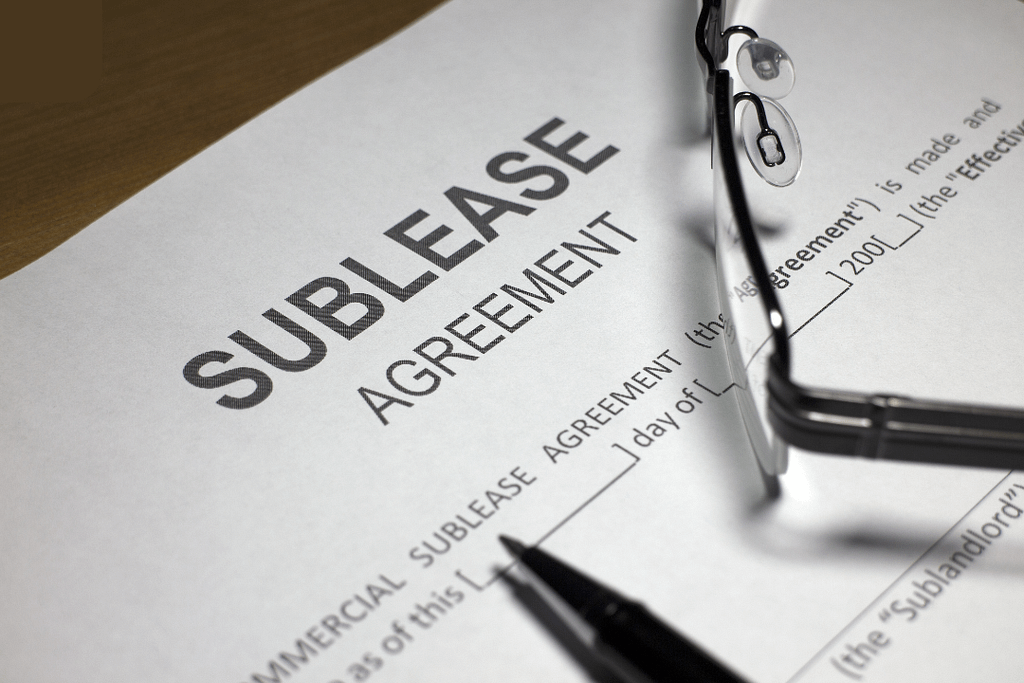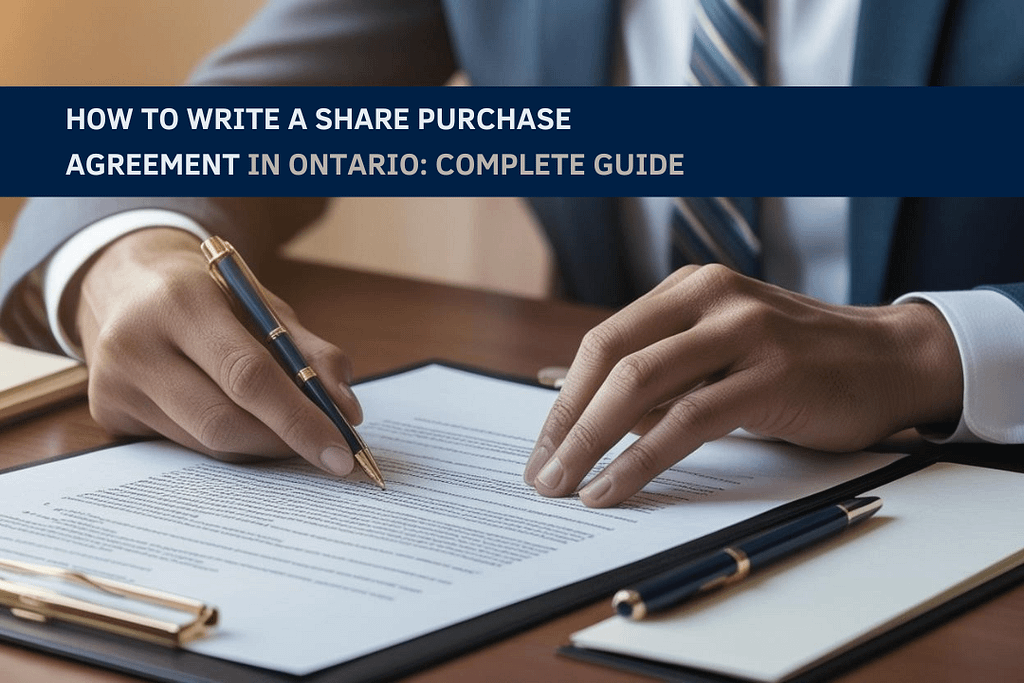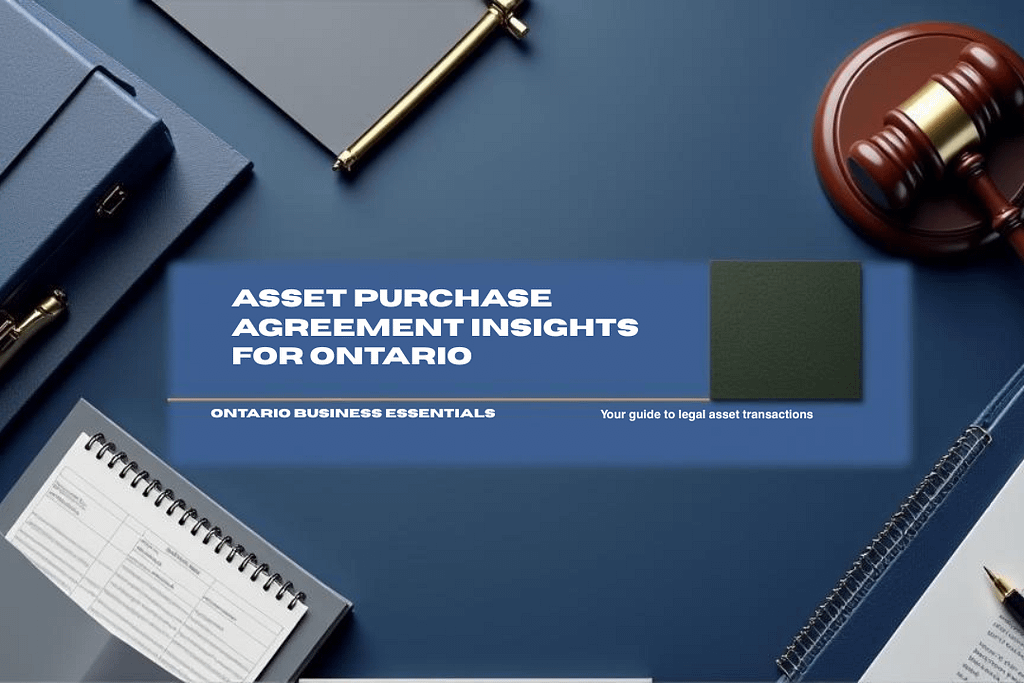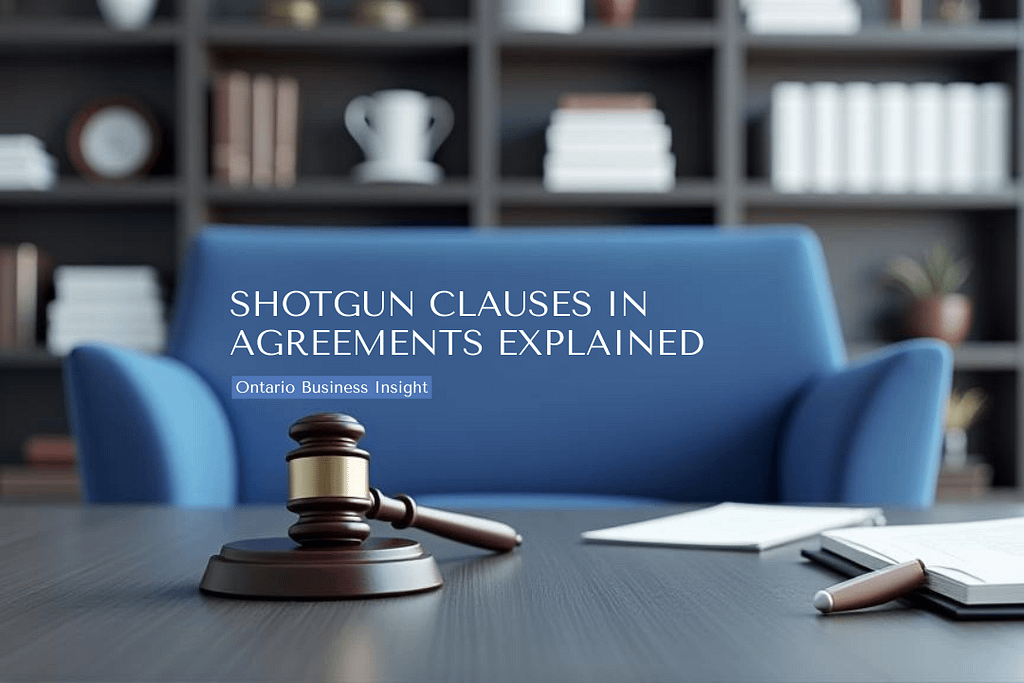A Sublease is a contract where a commercial tenant (the Sublandlord) rents out all or part of their leased space to another business (the Subtenant). The Sublandlord remains responsible under the original lease, while the Subtenant pays rent to the Sublandlord and occupies the space. In a Sublease, the original lease stays in effect, but a separate agreement governs the relationship between the tenant and Subtenant.
For example, a retailer might lease a large storefront, then sublet unused offices to a smaller shop under a Sublease contract. Ontario’s Commercial Tenancies Act (CTA) and case law apply to commercial leases, and they treat Subleases as valid arrangements (Subject to any landlord consent clauses and reasonable limitations). This guide explains how commercial Subleases work in Ontario, what to include in the agreement, and why having a written Sublease contract is essential.
What is a Sublease Agreement?
A Sublease agreement is a separate contract between the original tenant (Sublandlord) and a Subtenant. Under this agreement, the Subtenant can use the leased premises for a fixed term and at a set rent, while the original lease continues between the Sublandlord and the landlord. The Subtenant’s rights come only from the Sublease; the Subtenant has no direct contract with the landlord. Importantly, the Sublandlord (original tenant) “is still responsible for the original lease” and must keep paying rent and fulfilling other obligations to the landlord. A Sublease should clearly state what space is Sublet, the rent and term, and that the Subtenant must obey the same basic rules as the original lease. In practice, a Sublease gives businesses flexibility: one company can share or reduce its rented space by having another business fill part of the premises, as long as everyone’s obligations are documented.
Example of a Sublease
Suppose Company A leases an office suite from a landlord under a 5-year lease. After two years, Company A’s space needs shrink, so it makes a deal with Company B. Company A (Sublandlord) and Company B (Subtenant) sign a Sublease agreement: Company B rents one floor of the office for the remaining three years, paying a monthly rent to Company A. The Sublease spells out that Company B must follow the building’s rules and pay for any damages it causes. Meanwhile, Company A remains on the hook for the original lease- it continues to pay the landlord the rent and must ensure Company B does not break the lease. This written Sublease protects both parties: Company B knows its rent and term upfront, and Company A has a contract to enforce if Company B fails to pay or damages the space.
Why Do You Need a Sublease Agreement?
A Sublease agreement is crucial to protect everyone’s interests and avoid disputes. It provides legal clarity on each party’s rights and duties. For instance, it confirms exactly how much rent the Subtenant pays, the dates of the Sublease term, which parts of the property are included, and who handles repairs and utilities. Without it, there is no enforceable record of the deal. A written Sublease also helps manage the landlord’s expectations. Most commercial leases require the tenant to get written permission before Subletting. Having a formal Sublease makes it easier to show the landlord that the arrangement is well-defined and compliant.
Legally, a written Sublease is binding on the Sublandlord and Subtenant. It’s a contract: if either party breaks its terms (for example, if the Subtenant stops paying rent or the Sublandlord fails to maintain the property), the other can take legal action. In Canada, courts recognize Subleases as enforceable agreements so long as they meet basic contract requirements. Case law shows that Canadian courts will interpret the Sublease in light of the Commercial Tenancies Act and contract law to honour the parties’ intentions.
Key Elements of a Sublease Agreement Template
A well-drafted commercial Sublease agreement typically includes the following parts:
1. Parties and Property
Full legal names of the Sublandlord (original tenant) and Subtenant, and a clear description of the leased premises (address, suite number, square footage). Some forms even name the original landlord for reference.
2. Term (Duration)
The start and end dates of the Sublease. Often this is a portion of the head lease’s remaining term. The agreement should state any renewal or extension options.
3. Rent and Payment
The exact amount of rent the Subtenant will pay, how often (monthly, quarterly), and where or to whom it is paid (usually to the Sublandlord). Late fees or adjustments (e.g. rent increases) belong here.
4. Utilities and Expenses
Specify which utilities or common-area costs the Subtenant covers (such as electricity, water, property tax, maintenance fees) and which remain the Sublandlord’s obligation.
5. Security Deposit
If required, the contract should state the deposit amount (e.g. one month’s rent) and the conditions for its return at lease end. (Commercial leases don’t have a statutory last-month requirement like residential laws, but parties often agree on a deposit or pre-paid rent.)
6. Compliance with Head Lease
A clause noting that the Subtenant must obey all material terms of the original lease (use of premises, insurance, repairs, etc.). The Sublease should explicitly state it is “Subordinate” to the original lease. For example, the agreement can say that if any term of the Sublease conflicts with the head lease, the head lease governs.
7. Landlord Consent
If the original lease requires landlord permission, the Sublease should note that consent has been obtained (or will be sought). This may involve attaching the landlord’s consent letter.
8. Repairs and Maintenance
Who is responsible for maintaining the premises and making repairs during the Sublease period.
9. Permitted Use
The allowed use of the space (e.g. office, retail). This must not violate the head lease’s use clause or any zoning rules.
10. Insurance and Liability
The agreement should require the Subtenant to carry liability insurance (often named as additional insured under the landlord’s policy) and specify who pays premiums. This protects the Sublandlord and landlord if the Subtenant causes damage or injury.
11. Default and Termination
What constitutes a default (e.g. non-payment of rent, illegal activity), and what remedies are available (late fees, eviction notice). Also include rights to terminate early (if any) or what happens if the head lease ends or is breached.
12. Signatures and Date
Finally, the Sublessor and Subtenant (and sometimes a witness or lawyer) must sign and date the document. This formalizes the contract.
Key Statutory Framework
The Commercial Tenancies Act (CTA) provides the foundational legal framework for commercial Subleasing in Ontario. Several crucial sections directly impact Sublease arrangements:
- Section 3 establishes that the landlord-tenant relationship does not depend on tenure, and a reversion in the lessor is not necessary to create this relationship. This provision has been instrumental in modern Sublease interpretations.
- Section 17 addresses the effect of surrender or merger of reversion, stating that when a reversion expectant on a lease merges or is surrendered, the next vested right to the land becomes the reversion expectant on the lease. This protection ensures continuity for Subtenants when head leases are surrendered.
- Section 21 provides crucial protection for Subtenants when head landlords enforce re-entry or forfeiture rights. This section permits Subtenants to apply to the court for relief from forfeiture, allowing them to retain their premises as direct tenants of the head landlord under specified conditions.
- Section 39(2) grants Subtenants additional rights in cases of bankruptcy or insolvency of the head tenant, allowing them to elect to stand in the same position as direct lessees within three months of the bankruptcy filing
Case laws
V Hazelton Limited v. Perfect Smile Dental Inc. (2019 ONCA 423)
Hazelton leased commercial premises from Perfect Smile with a five-year renewal option. In 2016, Hazelton subleased the premises to a retail clothing store, with both the head lease and Sublease expiring on the same date (September 30, 2017). Notably, Hazelton did not reserve the last day of the head lease term, and the Sublease expressly excluded any renewal rights. The central issue was whether failing to reserve the last day of the head lease term created an assignment rather than a Sublease, thereby forfeiting Hazelton’s right to exercise the renewal option.
The Ontario Court of Appeal held that despite not reserving the last day, the arrangement remained a Sublease rather than an assignment. The court relied on Section 3 of the CTA and emphasized that courts should consider the objective intentions of the parties as evidenced by the contract terms. Since the Sublease expressly denied the Subtenant any renewal rights, sufficient evidence existed that the parties intended a Sublease, not an assignment.
Campbell v. 1493951 Ontario Inc. (2021 ONCA 169)
Campbell operated a cannabis store under an oral Sublease from Tri-Echo Restaurants Inc. The head lease required all business activities to comply with applicable laws. The cannabis operation lacked proper licensing under provincial cannabis legislation. The head landlord (149) provided notice of breach in August 2019 but did not act until April 2020, during which time it continued accepting rent payments.
The Court of Appeal applied the Supreme Court of Canada’s decision in Saskatchewan River Bungalows Ltd. v. Maritime Life Assurance Co. regarding waiver. The court found that waiver requires: (1) full knowledge of rights and (2) unequivocal and conscious intention to abandon them. The court determined that the landlord’s delay and acceptance of rent payments did not constitute waiver because the tenant had misled the landlord about having valid licensing exemptions.
Pinnacle International (One Yonge) Ltd. v. Torstar Corporation (2024 ONCA 755)
Torstar’s lease required it to pay Pinnacle any net “profit” earned from Subleasing. Torstar Subleased part of its premises to College Boreal. The lease covered 65,534 sq. ft. including unusable open-air space, but the Sublease only covered 46,707 sq. ft. of usable space. Despite Torstar suffering a $2.6 million loss overall, Pinnacle claimed $1.1 million in profit because Torstar charged Boreal more per usable square foot.
The Ontario Court of Appeal ruled in favour of Torstar, holding that:
- Courts must consider the factual matrix when interpreting lease terms
- “Profit” should be understood in its ordinary sense as “excess of returns over expenditure”
- Since Torstar paid more total rent than it received from the Subtenant, no profit existed
- The lower court’s interpretation would create a “commercial absurdity” giving the landlord an unintended windfall
This case emphasizes the importance of precise drafting in Sublease profit-sharing clauses and demonstrates courts’ willingness to consider commercial reasonableness in contractual interpretation.
Sublease Agreement vs. Lease Agreement
A Lease agreement (sometimes called a “head lease”) is the contract between the landlord and a tenant. A Sublease agreement is a separate contract between that tenant (now acting as Sublandlord) and a new Subtenant. In a lease, the tenant pays the landlord directly and the landlord deals only with that tenant. In a Sublease, the Subtenant pays rent to the original tenant, and the original tenant continues to pay the landlord.
The key differences are:
- Parties Involved: A lease has two parties (landlord and tenant). A Sublease has the tenant and Subtenant, with the landlord’s permission. The landlord is not a party to the Sublease (except to enforce the head lease), and the Subtenant usually has no direct rights under the head lease.
- Liability: In a lease, the tenant is fully responsible to the landlord for rent and obligations. In a Sublease, the original tenant remains ultimately liable to the landlord. If the Subtenant doesn’t pay or causes damage, the tenant must make it right under the head lease (and may then seek compensation from the Subtenant). For example, Ontario firms emphasize that “the original tenant (Sublessor) is still responsible for the lease” and must cover any shortfall.
- Reversion Interest: A lease conveys the right to use the property for the term. A Sublease conveys only what the tenant still holds. Importantly, an assignment of a lease (not a Sublease) transfers all the tenant’s interest to the new party. If the entire lease term and last day are transferred, it’s effectively an assignment, not a Sublease. Courts distinguish them: a true Sublease leaves a “reversion” with the original tenant (they retain some interest until the lease ends), whereas an assignment hands over the whole lease. However, Ontario law (Commercial Tenancies Act section 3) means the parties’ intent matters. In short, under a Sublease the tenant-seller remains a sort of “middleman” landlord; under an assignment the tenant-seller steps out entirely (Subject to landlord’s approval).
- Renewals and Options: If the head lease has renewal options, an assignment usually transfers those rights to the new lessee; a Sublease does not necessarily do so unless specifically stated. In a Sublease, unless the Sublease contract grants it, the Subtenant often cannot exercise renewal options without the landlord’s consent.
- Contract Scope: A lease covers the entire terms agreed with the owner. A Sublease is narrower: it references the head lease and covers only the portion of interest being Sublet. Nevertheless, a Sublease is “based on the original lease,” so the Subtenant must “carefully review the terms of both the Sublease and the original lease to minimise risk”.
For most tenants, a Sublease keeps the original lease in force and simply allocates some of its use and obligations to another party.
Common Mistakes to Avoid in Subleasing
Even well-intentioned businesses can slip up when Subleasing. Common pitfalls include:
- No Written Agreement: One of the biggest mistakes is relying on verbal promises or informal messages. Without a signed Sublease, there’s no enforceable proof of the deal. A Sublease should be in writing and detail the term, rent, and responsibilities.
- Skipping Landlord’s Approval: Even if you find a Subtenant quickly, don’t assume the landlord won’t care. In Ontario (and under most commercial leases), written permission is generally required. Doing the deal without consent risks violating the lease, which could lead the landlord to terminate the tenancy.
- Contradicting the Head Lease: A Sublease must not conflict with the original lease. For example, if the head lease forbids certain uses or requires specific insurance, the Sublease can’t ignore those rules. Tailoring the Sublease to mirror the important terms of the head lease is crucial.
- Vague Responsibilities: People often forget to clearly assign duties. Who fixes leaks, replaces broken equipment, or pays for maintenance? Leaving this undefined invites disputes. The Sublease should unambiguously state who handles repairs and ongoing upkeep.
- Unclear Duration or Exit: Ambiguous terms about how long the Sublease lasts or how it can be ended cause confusion. For instance, not specifying a firm end date or notice period can create legal uncertainty. All termination and renewal conditions must be properly set out.
- No Tenant Screening: If you’re the Sublandlord, failing to vet the Subtenant is a risk. You stay on the hook, so you need a reliable Subtenant. Check their credit, references, and business history.
- Financial Traps: Trying to “profit” by charging a lot above your rent can backfire. Many leases forbid a tenant from making a profit on a Sublease. Overcharging can lead to lease violations or landlord objections. Also, taking a large security deposit without the landlord’s knowledge can violate local rules or the lease.
- Skipping Legal Review: Some try using generic templates or self-drafting the Sublease. This often overlooks nuances. A good contract lawyer can catch issues (like special clauses in the head lease, insurance needs, or market norms) that a standard form might miss.
Avoiding these mistakes requires attention and sometimes legal help. It’s always better to get the Sublease paperwork right at the start to avoid costly problems later.
When to Seek Legal Advice
Subleasing can involve complex landlord-tenant rules and contracts, so it’s wise to get a lawyer’s help in several situations:
- Lease Review Before Subletting: If you’re not certain whether your commercial lease even allows Subleasing (or if it has strict conditions), a lawyer should review it first. Some leases ban Subletting outright, while others allow it with consent. A lawyer can pinpoint any clauses (like a required notice period or “prohibition of Subletting”) that you must follow.
- Obtaining Consent: If landlord approval is needed, a lawyer can draft a consent request that addresses the landlord’s concerns. They know what landlords typically look for (creditworthy Subtenant, no change in premises, insurance) and can frame your Sublease proposal accordingly.
- Drafting the Sublease: Lawyers are experts at putting all terms into proper legal language. They can ensure the Sublease includes every important clause (rent, term, liabilities, etc.) and aligns with Ontario law. For example, lawyers emphasize that a complete Sublease “covers all necessary terms, including rent, security deposit [and] Subtenant’s responsibilities”. They will also tailor the contract so it won’t inadvertently breach the head lease.
- Insurance and Liability: A lawyer can advise on what insurance the Subtenant or Sublandlord should carry, and draft indemnities to protect against damages or accidents.
In summary, engaging a lawyer is beneficial at key stages: checking your lease, getting permission, writing the Sublease, and handling any problems. Ontario lawyers with commercial real estate experience will be familiar with the Commercial Tenancies Act and local practices, which means your Sublease will be more secure.
Conclusion
Commercial Subleasing is a useful strategy for businesses to manage space and costs, but it must be done carefully. In Ontario, there is no automatic right to Sublet; the original lease usually governs whether and how you may do so. The key is clarity: review the head lease, get needed consent, and put the Sublease terms in writing. Ontario’s laws (especially the Commercial Tenancies Act) and recent court decisions make it clear that the details of the Sublease matter (for example, in the case of Kennedy v. Agricultural Development Board (1926), 1926 CanLII 323 (ON SC), 59 OLR 374 (HC) the court interpreted CTA s.3 allows a Sublease even if the final lease day isn’t “reserved,” provided the intent was not to assign). Likewise, CTA s.23 treats any no-Sublease clause as implying that the landlord can’t unreasonably refuse consent.
To protect yourself, always document the agreement and consider professional advice. A good Sublease agreement helps prevent disputes, ensures compliance with the law, and keeps the commercial tenancy running smoothly. Whether you are the tenant Subletting out space or the Subtenant moving in, a clear contract backed by legal safeguards is the best way to make the arrangement work for everyone.
Ready to Secure Your Sublease Agreement?
Contact the commercial leasing experts at Pacific Legal today for a free consultation! Get peace of mind with professional contract drafting, compliance reviews, and landlord-tenant negotiation support.
Book Your Free Consultation Now for quick, confidential advice from Ontario’s trusted business law team.
FAQ
1. Do I need permission from my landlord to Sublease?
It depends on your lease. Many commercial leases require prior written consent before Subletting. Ontario law (Commercial Tenancies Act s.23) actually presumes that if a lease forbids Subletting without consent, the landlord cannot unreasonably withhold permission. In practice, you should obtain consent in writing. If a landlord unreasonably refuses, Ontario courts can even order the Sublease to go ahead as if consent were given.
2. What should be included in a Sublease agreement template?
At minimum, include the names of all parties (Sublandlord, Subtenant, and reference to landlord), a description of the premises, the term (start and end dates), and the rent amount and payment schedule. Also cover utilities, maintenance responsibilities, and any security deposit. Importantly, note that the Subtenant will follow the original lease’s rules; one template advises that if the Sublease has any conflict, the original lease “wins”. Other key clauses: termination/default conditions, insurance, permitted use of premises, and signatures. An experienced lawyer can help tailor the template so no critical details are missed.
3. Is a Sublease agreement legally binding in Canada?
Yes. A Sublease is a legal contract. If properly executed (written, signed, with consideration like rent), it creates enforceable rights between Sublandlord and Subtenant. Canadian courts will enforce a Sublease as a valid lease contract, so long as it doesn’t violate any laws or the head lease. (For example, in Kennedy, the Ontario Court of Appeal recently enforced a Sublease renewal where parties clearly intended a Sublease rather than an assignment.)
4. Can a landlord refuse a Sublease in Ontario?
Under the CTA, a landlord may not arbitrarily refuse. If your lease requires consent, section 23 of the CTA says that consent “is not to be unreasonably withheld”. So, the landlord must have a good reason (poor credit, illegal Subtenant, etc.). If the landlord withholds consent without reasonable grounds, a tenant or Subtenant can ask the Superior Court to permit the Sublease. In short, a landlord should not outright refuse in a capricious way, but might refuse if legitimate issues are present. Always check your lease: if it says “no Subletting,” that itself triggers the CTA rule implying reasonableness.
5. Can commercial properties be Subleased?
Yes. Commercial spaces are routinely Sublet, as long as the lease allows it (or the landlord consents). There is no general prohibition on Subletting commercial property in Ontario. Businesses often Sublet offices, shops, or warehouses when they have excess space or want to share costs. It’s legally permissible, Subject to your lease terms and landlord’s approval.
6. Who is responsible for damages in a Sublease?
Typically, the Subtenant is responsible for any damage they cause during the Sublease term. The Sublease should explicitly require the Subtenant to repair or pay for damage they create. However, remember that under the head lease, the original tenant is ultimately responsible to the landlord. That means if the Subtenant causes damage, the Sublandlord (original tenant) must fix it or pay for it to the landlord, and then can seek reimbursement from the Subtenant per their agreement. It’s common (and prudent) to have the Subtenant carry liability insurance. Lawyers emphasize understanding Sublandlord liability and getting insurance so one party doesn’t bear unexpected losses.
7. How to draft a Sublease agreement?
Start by reviewing the head lease to see what it allows. Then prepare the Sublease with the elements above: list all parties, describe the premises and term, set the rent and payment method, and enumerate each party’s duties (repairs, utilities, etc.). Mention the landlord’s consent status. Use clear, precise language; avoid generic phrases that could conflict with your lease. Before signing, double-check that the Sublease doesn’t override any clauses of the head lease; after all, any conflict will be resolved in favour of the original lease. If possible, have a real estate lawyer review the draft. They can ensure all key terms (rent, term, liabilities, termination, insurance) are covered and legally sound.








